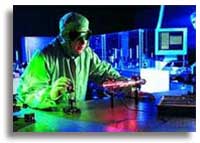PHOTONICS
Introduction to the Career
Those who have a keen interest in science and its intricacies and are curious to solve questions related to science can pursue Photonics as a career. There is a global demand for skilled people with Photonics training. A Photonics specialist is usually an Engineer, technician, or scientist in Photonic companies and works as a professional officer in universities and Government offices. The nature of work differs with the post held. The scientist has to do more research work on Photonics, while the engineers design Photonic equipments. The Photonics technician helps the engineers in designing and manufacturing.
Light particles called photons can store information and help to transfer this information through very thin glass fibers that can carry the equal of 300,000,000 simultaneous telephone calls. The study of photons is called Photonics, the technology of light energy. Photonics is considered to be the next generation technology. Just as electronics is the technology of the 20th century, Photonics could be the technology of the 21st century. Even though the Photonic era began in the 1960's with the invention of laser, it made an impact on telecommunication only in the late 70's.
Photonics is a hi-tech subject that evolved as a result of the fusion of optical technology with electronics. It is the use of light to obtain, convey or process information. It is the science of mastering the techniques involved in the emission, detection, transmission and modulation of light. This sub-discipline of physics deals with the study of photons, the elementary particle of light. It also deals with the instruments required such as laser guns, optical fibers, optometric instruments, etc. In Photonic system, information signals are conveyed as pulses of light and these optical signals are transmitted through optical fibres. Optical fibres are strands of special glass around 10 micron (100�m) in diameter (i.e about the thickness of a human hair) which can carry thousands of times more information than electrical wires. Photonic devices are used to convert electrical signals into optical signal and back again where necessary can be made up from a variety of materials including semi conductors and even optical fibres. These devices are also used to manipulate and process optical signals directly, without the need for conversion.
Nature of work and Job Description

In recent years, Photonics has usually become a fundamental technology in worldwide telecommunication, computing, security and many other applications because of its advantage to work more effectively and with much greater speed.
There is much scope for graduates in the field as Photonics industry is in need of more qualified and experienced people. Mostly they could work for telecommunication companies. They could also find key positions in a variety of other industries and R & D organizations involved in the area of networks, semiconductor technology, fiber and integrated optics, optoelectronics and software.
Photonics companies that supply optical components and systems need people who are Photonics graduates and experts to design, manufacture and test photonics components. In industrial manufacturing, a career in photonics is helpful since laser is used for cutting, drilling and welding. In the manufacture of semi-conductors too, photonics is used not only for imaging circuit layers but also for measuring the size and location of patterned features. In automobile manufacture, photonics testing offers advantages over mechanical methods of testing interior and brake noise.
Top Recruiters and Companies

Remuneration

Institutes in India:
Some of the institutes offering courses in Photonics and related fields are :
Photography |
Success Stories
Ultrafast photonics has become an interdisciplinary topic of high international research interest because of the spectacular development of compact and efficient lasers producing optical pulses with durations in the femtosecond time domain. Present day long-haul telecommunications systems are almost entirely based on the transmission of short bursts or pulses of laser light along silicon optical fibres, with Erbium-doped fibre amplifiers inserted to regenerate the signals periodically. The phenomenal success of optical fibre communications has created a substantial opto-electronics industry that provides efficient laser sources, high-speed modulators, optical amplifiers and detectors.
Although optical data transmission is now well established, current systems approaches will eventually cease to meet the ever-increasing demands of data-communication. Existing wavelength division multiplexing (WDM) schemes will need to be complemented with time-domain multiplexing (TDM) techniques involving digital optical signals using ultrashort laser pulses.
